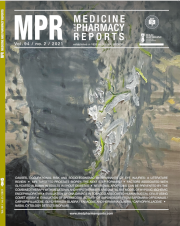Evaluation of DNA damage in tobacco associated human buccal cells using comet assay
DOI:
https://doi.org/10.15386/mpr-1692Keywords:
comet assay, DNA damage, tobaccoAbstract
Aim and objective. To assess the DNA damage in tobacco associated human buccal cells using comet assay.
Methods. The study included 75 study subjects, which were divided into 3 groups on the basis of tobacco usage. Group I - 25 individuals with no history of tobacco usage, Group II - 25 individuals with tobacco usage but without oral lesions and Group III - 25 individuals with tobacco associated oral lesions. Cytological smears collected from these individuals were used to assess the tobacco associated DNA damage by measuring the tail length in the comet assay method.
Results. The average tail length was found to be 1.46 µm in the normal mucosa, 2.86 µm in tobacco users without oral lesions, 3.86 µm in the lesional sites of tobacco users and 3.67 µm in the non-lesional sites of these individuals. Factors like age, gender, duration and different forms of tobacco habit had their own impact on the oral mucosa.
Conclusion. Comet assay helps assess the subclinical genetic changes of oral mucosa even before the clinical manifestations of the precancerous lesions appeared due to tobacco usage. Thus, comet assay may bloom out as a novel adjuvant tool for the prevention of oral cancer in the near future.
Downloads
Published
How to Cite
Issue
Section
License
The authors are required to transfer the copyright of the published paper to the journal. This is done by agreeing to sign the Copyright Assignment Form. Whenever the case, authors are also required to send permissions to reproduce material (such as illustrations) from the copyright holder.

The papers published in the journal are licensed under a Creative Commons Attribution-NonCommercial-NoDerivatives 4.0 International License.

